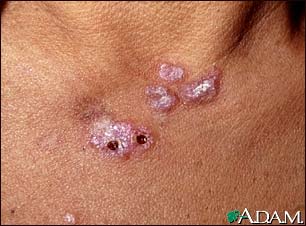Definition
Drug-induced lupus erythematosus is an autoimmune disorder that is brought on by a reaction to medication.
See also: Systemic lupus erythematosus (SLE)
Overview, Causes, & Risk Factors
Drug-induced lupus erythematosus is similar to systemic lupus erythematosus (SLE). It is caused by a hypersensitivity reaction to a medication. The drug may react with cell materials, causing the body to form antibodies that attack the body’s own healthy cells.
Several medications are known to cause drug-induced lupus. They include:
- Chlorpromazine
- Hydralazine
- Isoniazid
- Methyldopa
- Penicillamine
- Procainamide
- Quinidine
- Sulfasalazine
Symptoms tend to occur after taking the drug for at least 3 to 6 months.
Persons with drug-induced lupus erythematosus may have symptoms that affect the joints (arthritis), heart, and lungs. Other symptoms associated with SLE, such as lupus nephritis and nervous system (neurological) disease, are rare.
Drug-induced lupus affects men and women equally.
Pictures & Images
Lupus, discoid – view of lesions on the chest
 Lupus, discoid – view of lesions on the chest: This close-up picture of the neck clearly shows the typical rounded appearance of discoid lupus. The whitish appearance is caused by scaling. The two dark spots are biopsy sites and are not part of the disease.
Lupus, discoid – view of lesions on the chest: This close-up picture of the neck clearly shows the typical rounded appearance of discoid lupus. The whitish appearance is caused by scaling. The two dark spots are biopsy sites and are not part of the disease.
Lupus, discoid on a child’s face

The round or disk shaped (discoid) rash of lupus produces red, raised patches with scales. The pores (hair follicles) may be plugged. Scarring often occurs in older lesions. The majority (approximately 90%) of individuals with discoid lupus have only skin involvement as compared to more generalized involvement in systemic lupus erythematosis (SLE).
Lupus, discoid on the face

The rash of lupis is round or disk shaped (discoid) and is characterized by red, raised patches with adherent scales. The skin pores (follicles) may be plugged, and scarring often occurs in older lesions. Approximately 90% of individuals with discoid lupus have only skin involvement as compared to more generalized involvement in systemic lupus erythematosis (SLE).
Antibodies

Antigens are large molecules (usually proteins) on the surface of cells, viruses, fungi, bacteria, and some non-living substances such as toxins, chemicals, drugs, and foreign particles. The immune system recognizes antigens and produces antibodies that destroy substances containing antigens.
-
Drug-induced lupus erythematosus : Overview, Causes, & Risk Factors
-
Drug-induced lupus erythematosus : Symptoms & Signs, Diagnosis & Tests
-
Drug-induced lupus erythematosus : Treatment


Review Date : 5/31/2009
Reviewed By : Mark James Borigini, Associate Clinical Professor of Medicine, University of California, Irvine, Irvine, CA. Review provided by VeriMed Healthcare Network. Also reviewed by David Zieve, MD, MHA, Medical Director, A.D.A.M., Inc.
The information provided herein should not be used during any medical emergency or for the diagnosis or treatment of any medical condition. A licensed medical professional should be consulted for diagnosis and treatment of any and all medical conditions. Call 911 for all medical emergencies. Links to other sites are provided for information only — they do not constitute endorsements of those other sites. © 1997- 2010 A.D.A.M., Inc. Any duplication or distribution of the information contained herein is strictly prohibited.
